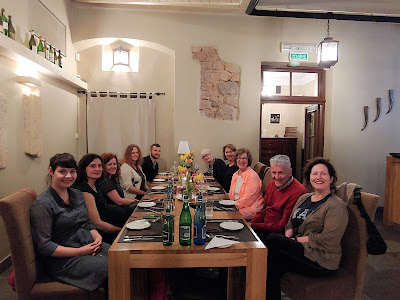My good friend Tadeusz Przystojecki from Grodzka Gate Theater NN in
Lublin, Poland passed away in February. Tadeusz was a historian, archivist, genealogist and I will remember him as a kind and generous soul who was
passionate about piecing together the stories of our
murdered families. In 2017, he introduced me to my ancestral home, Lublin, and to my family's history. Tadeusz was 40 years old and died of pancreatic cancer.
I am grateful we met in person. The first time, in 2017, when Jon and I traveled to the Lubliner Reunion - a gathering of 200+ descendants from Lublin's former Jewish community hosted by Grodzka Gate Theater. And the second time, in 2019, when I met his colleague and friend Jackie Schwarz in Antwerp, Belgium and then together, visited Lublin once again.
Tadeusz taught me much about Lublin's history. A few years ago, I asked him to recommend books about the interwar years (between WW1 and WW2) and the Holocaust. He suggested Bloodlands: Europe Between Hitler and Stalin, On Tyranny: Twenty Lessons from the Twentieth Century by Timothy Snyder and East West Street: On the Origins of Genocide and Crimes Against Humanity by Philippe Sands. Tadeusz also recommended Neighbors, by Jan Gross a book about the murder of Jews by their neighbors in Jedwabne, Poland. Tadeusz died on the day Ukraine was invaded by its neighbor, Russia, on February 24.
Tadeusz not only taught me about Lublin's history, but also about the city today and introduced me to his colleagues and friends who also dedicate their lives to helping others. I hear from them that they are working very hard to support the refugees from Ukraine. I can't imagine what it's like there now. I recall traveling with Tadeusz and a group of friends and researchers in 2019 to the city of Przemysl and the village of Rybotycze in Southeast Poland very near the Ukraine border. The beautifully restored train station in Przemsyl is now one of the major depots where thousands of Ukrainian refugees arrive daily. I am not surprised that this talented and extraordinary group has welcomed refugees to Poland, just as they welcomed so many of us, descendants of Jewish Lubliners.
When remembering Tadeusz, someone described him as a “mench,”
the Yiddish word for “a good person, a person with the qualities one would hope
for in a friend or trusted colleague.” He was the best of us. May his memory be
a blessing.
 |
| Tadeusz presented my family's history at the Lubliner Reunion |
 |
| Our mini-reunion in 2019, Tadeusz helped me coordinate a 'thank you' dinner |
 |
| In the village of Rybotycze, meeting Henik, who renovated the Jewish cemetery, with his wife Hanna and friend Margaret |
 |
| Touring Grodzka Gate Theater NN in Lublin |
 |
| At the train station in Przemysl |

























